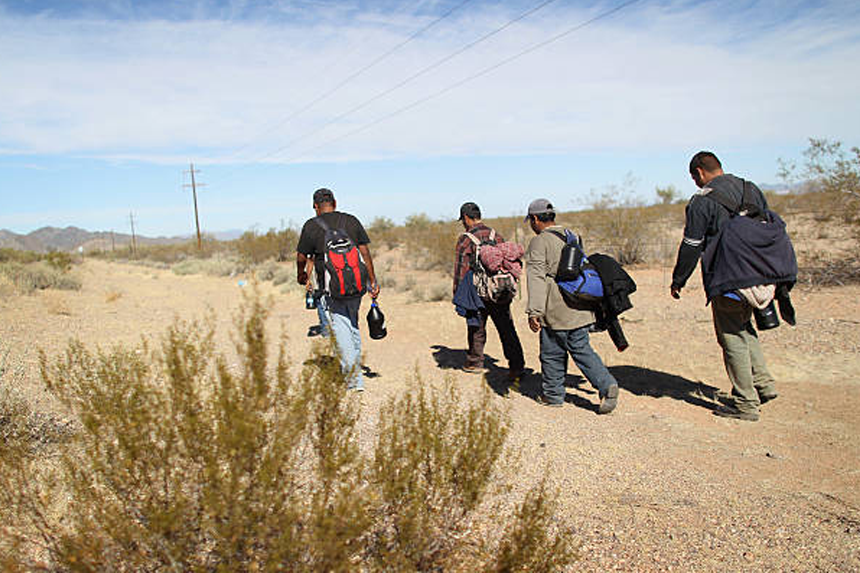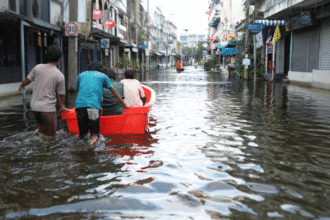22% of foreign-born people and 3% of the US population are undocumented immigrants. The amount of undocumented Indian immigrants among them is still up for debate, though, as estimates vary greatly depending on how they are calculated.
- Why Did the Number of Undocumented Indian Immigrants Drop So Steeply Between 2016 and 2022?
- Where Do Most Undocumented Indian Immigrants Enter the US From?
- Which States Have the Highest Numbers of Unauthorized Indian Immigrants?
- How Do Asylum Claims Fit Into the Immigration Trends?
- Why Have Indian Asylum Requests Surged in Recent Years?
- What Role Do Agents and Brokers Play in This Migration Trend?
- How Many Indians Have Been Deported from the US?
According to estimates from the Center for Migration Studies of New York (CMS) and the Pew Research Center, there will be about 700,000 undocumented Indian immigrants in 2022, ranking third in size behind El Salvador and Mexico. On the other hand, the Migration Policy Institute (MPI) ranks India fifth among countries of origin with a total of 375,000. In 2022, there were 220,000 undocumented Indian immigrants, according to official Department of Homeland Security (DHS) figures.
The disparity in approximations highlights the ambiguity surrounding the actual number of undocumented Indian immigrants. One study claims that the proportion of Indian migrants in the US’s total undocumented migrant population is quite low. Nearly one in four Indian immigrants in the US are undocumented, if Pew and CMS figures are correct, yet given migration trends, this is regarded as an implausible situation. From 600,000 immigrants in 1990 to 3.2 million in 2022, the Indian immigrant population is one of the fastest-growing in the United States.
Why Did the Number of Undocumented Indian Immigrants Drop So Steeply Between 2016 and 2022?
According to DHS estimates, the number of undocumented Indian immigrants in the United States decreased from 560,000 to 220,000, a 60% decrease, between 2016 and 2022. The legal status that some people have achieved or their return to India, especially as a result of the COVID-19 pandemic’s hardships, are some tenable explanations, even though the data does not offer a clear answer. The number of undocumented Indian immigrants may really be larger, though, as this estimate does not account for the spike in border encounters in 2023.
According to US official estimates, there was no discernible rise in the total number of undocumented Indian immigrants between FY 2020 and 2022, despite an increase in border encounters. When non-citizens are halted by US officials while trying to enter the country from Mexico or Canada, this is referred to as an encounter. Since 2016, the percentage of Indian visa overstays has stayed constant at 1.5%. Furthermore, from 2,600 in 2017 to 1,600 in 2024, fewer Indians were granted Deferred Action for Childhood Arrivals (DACA).
Where Do Most Undocumented Indian Immigrants Enter the US From?
The southern border with Mexico and the northern border with Canada are the two main land borders of the United States. In the past, before 2010, there had never been more than 1,000 Indian confrontations along these borders. Nearly every interaction with Indians since 2010 has taken place at the southern border between the United States and Mexico.
However, in FY 2024, encounters of Indian nationals on the northern border surged to 36% of all Indian crossings, up from just 4% the previous year. Canada has become a more accessible entry point for Indians, with shorter visitor visa processing times compared to the US. Additionally, there has been a surge in attempted border crossings from 2021 onwards, with encounters at the Mexico border peaking in 2023.
“Indians are not the only ones affected. Following Biden’s election, there has been a greater influx of migrants attempting to enter the US. One analyst observed, “It seems like there was a surge of migrants, and Indians were included in it.”
Which States Have the Highest Numbers of Unauthorized Indian Immigrants?
Unauthorized Indian immigrants are most prevalent in California, Texas, New Jersey, New York, and Illinois, the states having the biggest concentrations of Indian immigrants. Indians are a sizable portion of the total undocumented population of Pennsylvania (11%), New Jersey (12%), Michigan (14%), and Ohio (16%). Over 20% of Indian immigrants are illegally in states including California, Georgia, Indiana, Tennessee, and Wisconsin.
According to a migration patterns specialist, “this is expected because it is easier to blend in and find work in ethnic businesses, like a Gujarati working for a Gujarati-American or a Punjabi/Sikh in a similar setup.”
How Do Asylum Claims Fit Into the Immigration Trends?
In tandem with an increase in border apprehensions, the United States immigration system permits migrants who are held at the border who fear persecution in their home countries to submit to credible “fear screenings.” Those who pass can then apply for asylum in court.
The precise demographics of Indian asylum applicants are not disclosed by administrative data, although court records on spoken languages offer some information. Since 2001, the majority of Indian asylum applications have been made by Punjabi speakers, who are followed by Hindi, English, and Gujarati speakers. Punjabi speakers made up 66% of asylum cases between FY 2001 and 2022, and they had the highest clearance rate of any Indian language group at 63%. Only a quarter of Gujarati speakers’ cases were allowed, compared to 58% for Hindi speakers.
Why Have Indian Asylum Requests Surged in Recent Years?
According to US data from the Organization for Economic Co-operation and Development (OECD), the number of Indian asylum claims has increased dramatically. From over 5,000 in 2021 to over 51,000 in 2023, the number has increased tenfold. Similar trends are seen in Canada, the UK, and Australia, where Indians make up one of the greatest groups of asylum seekers, proving that this tendency is not just in the US.
This spike, according to one analyst, is “largely a way to game the asylum system rather than an objective fear of persecution, as processing takes years.” Although it may appear that India’s “democratic backsliding” is the cause of the surge in refugee petitions, the authors of a study contend that correlation does not equate to negligence.
The wealthier Indian states of Punjab and Gujarat have a long history of emigration, with people moving not just to the US but also to the UK, Canada, and Australia. Remittances, which were predicted to be worth $120 billion in 2023, support hopes for a better life that are motivated by “relative deprivation” rather than poverty. Families want to succeed as much as others elsewhere, which fuels the need for migration.
What Role Do Agents and Brokers Play in This Migration Trend?
This demand has led to the growth of a parallel Indian agent and broker sector, which assists migrants in navigating the frequently difficult route to the United States. This relocation frequently requires substantial financial resources, especially for people from wealthy regions like Gujarat and Punjab. Only those who can sell or pledge assets can afford the trip, which can cost anywhere between 30 and 100 times India’s per capita income.
According to the study, “Even illegality takes a lot of money to pursue,”
How Many Indians Have Been Deported from the US?
According to India’s Ministry of External Affairs, approximately 16,000 Indians were deported between 2009 and 2024, with the highest number occurring in 2020 with nearly 2,300 deportations. Deportations averaged 750 annually during Obama’s presidency, 1,550 during Trump’s first term, and 900 under Biden.
A sizable section of the Indian migrant population faces unclear futures as deportations increase due to an increase in border encounters. The patterns and causes of India’s undocumented migration trend continue to influence US immigration policy and its effects on the countries and migrants.








